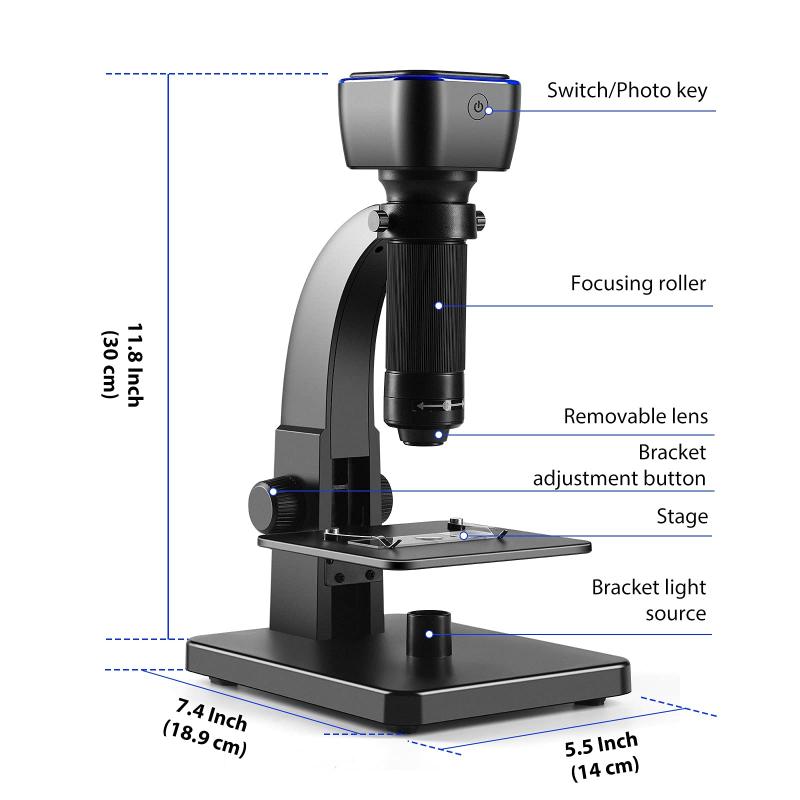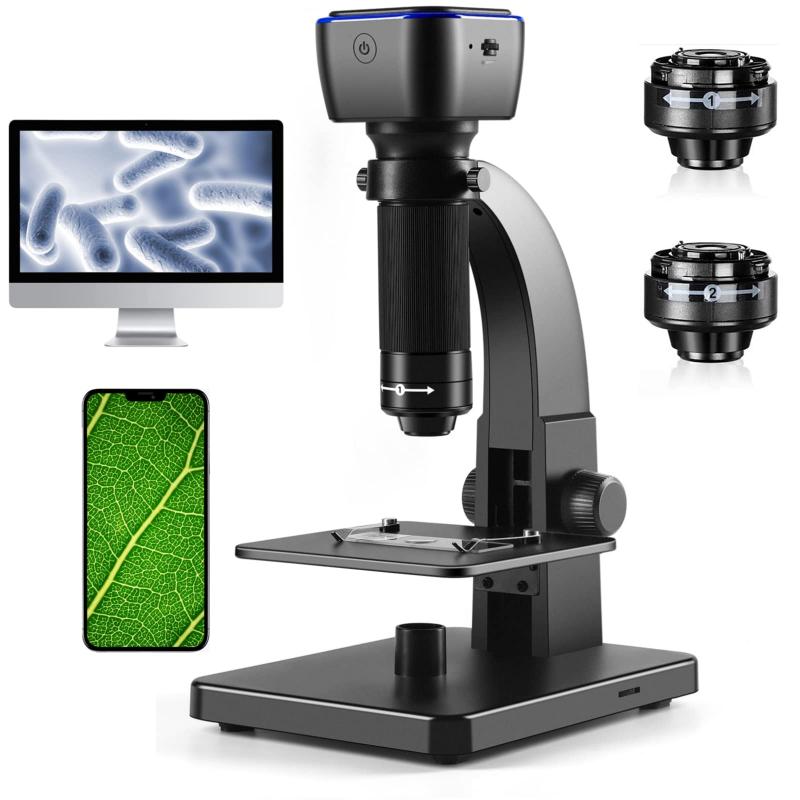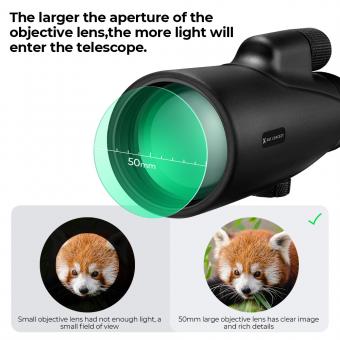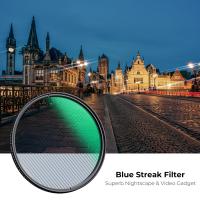Why Can't Ribosomes Be Seen Through A Microscope ?
Ribosomes are too small to be seen through a regular light microscope. They have a diameter of about 20 nanometers, which is below the resolution limit of light microscopes. Light microscopes use visible light to illuminate and magnify objects, but the wavelength of visible light is much larger than the size of ribosomes. As a result, the light waves cannot resolve the fine details of ribosomes, making them invisible under a light microscope. To visualize ribosomes, more powerful techniques such as electron microscopy are required, which use a beam of electrons instead of light to achieve higher resolution.
1、 Size: Ribosomes are too small to be resolved by light microscopy.
Ribosomes are essential cellular structures responsible for protein synthesis. Despite their crucial role, they cannot be directly observed through a light microscope. The primary reason for this is their size, as ribosomes are significantly smaller than the resolution limit of light microscopy.
Light microscopy relies on the interaction of light waves with the sample being observed. The resolution of a microscope is determined by the wavelength of light used and the numerical aperture of the lens system. The theoretical limit of resolution for light microscopy is approximately 200-300 nanometers, which is larger than the size of ribosomes. Ribosomes in eukaryotic cells are about 20-30 nanometers in diameter, while those in prokaryotic cells are even smaller, ranging from 15-25 nanometers.
To visualize structures smaller than the resolution limit, techniques such as electron microscopy (EM) are employed. Electron microscopes use a beam of electrons instead of light, which has a much shorter wavelength, allowing for higher resolution imaging. With EM, ribosomes can be observed in great detail, revealing their complex structure and organization within the cell.
In recent years, advancements in microscopy techniques have allowed for the visualization of cellular structures beyond the diffraction limit of light microscopy. Super-resolution microscopy techniques, such as stimulated emission depletion (STED) microscopy and stochastic optical reconstruction microscopy (STORM), have pushed the resolution down to the nanometer scale. These techniques have provided insights into the organization and dynamics of ribosomes within cells, shedding light on their functional roles.
In conclusion, ribosomes cannot be seen through a light microscope due to their small size, which falls below the resolution limit of this technique. However, with the advent of super-resolution microscopy, researchers have been able to overcome this limitation and gain a deeper understanding of ribosome structure and function.

2、 Resolution: The resolution of light microscopes is insufficient to visualize ribosomes.
Ribosomes, the cellular structures responsible for protein synthesis, are not visible through a light microscope due to the limitation of resolution. The resolution of a microscope refers to its ability to distinguish two closely spaced objects as separate entities. In the case of ribosomes, their size is on the order of nanometers, making them much smaller than the wavelength of visible light. The resolution of light microscopes is limited by the diffraction of light, which prevents the visualization of structures smaller than the wavelength of light.
Light microscopes use visible light to illuminate the sample and magnify the image using lenses. The wavelength of visible light ranges from approximately 400 to 700 nanometers, while ribosomes have a diameter of about 20 nanometers. This significant difference in size prevents the visualization of ribosomes using a light microscope. The diffraction of light causes the image to blur, making it impossible to resolve such small structures.
To overcome this limitation, scientists have developed more advanced microscopy techniques. Electron microscopy, for example, uses a beam of electrons instead of light to visualize structures at a much higher resolution. With electron microscopy, ribosomes can be observed in great detail, allowing researchers to study their structure and function.
In recent years, advancements in super-resolution microscopy techniques have pushed the boundaries of what can be visualized using light microscopes. These techniques, such as stimulated emission depletion (STED) microscopy and single-molecule localization microscopy (SMLM), have enabled the visualization of structures below the diffraction limit of light. However, even with these advancements, the resolution of light microscopes is still insufficient to directly visualize ribosomes.
In conclusion, the inability to see ribosomes through a light microscope is primarily due to the limitation of resolution. While advancements in microscopy techniques have allowed for the visualization of smaller structures, ribosomes remain beyond the reach of light microscopes due to their size relative to the wavelength of visible light.

3、 Limitations: Ribosomes fall below the limit of detection for light microscopy.
Ribosomes are essential cellular structures responsible for protein synthesis. However, they cannot be directly observed through a light microscope due to their small size. The main reason for this limitation is that ribosomes fall below the limit of detection for light microscopy.
Light microscopy relies on the use of visible light to illuminate and magnify the specimen being observed. The resolution of a light microscope is limited by the wavelength of visible light, which ranges from 400 to 700 nanometers. This means that the smallest structures that can be resolved by a light microscope are typically around 200 nanometers in size.
Ribosomes, on the other hand, are much smaller than the resolution limit of light microscopy. In prokaryotic cells, ribosomes have a diameter of about 20 nanometers, while in eukaryotic cells, they have a diameter of around 25 nanometers. These dimensions are well below the resolution limit of a light microscope, making it impossible to directly visualize ribosomes using this technique.
To overcome this limitation, scientists have developed more advanced microscopy techniques such as electron microscopy. Electron microscopy uses a beam of electrons instead of visible light to illuminate the specimen, allowing for much higher resolution imaging. With electron microscopy, ribosomes can be visualized in great detail, revealing their structure and organization within the cell.
In recent years, advancements in super-resolution microscopy techniques have also allowed for the visualization of smaller cellular structures, including ribosomes. These techniques, such as stimulated emission depletion (STED) microscopy and single-molecule localization microscopy (SMLM), can achieve resolutions beyond the diffraction limit of light, enabling the visualization of ribosomes and other nanoscale structures.
In conclusion, the small size of ribosomes falls below the limit of detection for light microscopy, making them invisible through this technique. However, with the development of more advanced microscopy techniques, such as electron microscopy and super-resolution microscopy, it is now possible to visualize ribosomes and gain a deeper understanding of their role in cellular processes.

4、 Optical properties: Ribosomes lack the necessary optical properties for visualization.
Ribosomes are essential cellular structures responsible for protein synthesis. Despite their crucial role, they cannot be directly observed through a conventional light microscope. The primary reason for this is their size and lack of optical properties.
Ribosomes are incredibly small, with a diameter of about 20 nanometers. This is far below the resolution limit of light microscopes, which typically have a resolution of around 200-300 nanometers. The resolution of a microscope is determined by the wavelength of light used to visualize the sample. As ribosomes are much smaller than the wavelength of visible light, they cannot be resolved individually.
Moreover, ribosomes lack the necessary optical properties for visualization. They do not possess any inherent color or fluorescence that can be easily detected by light microscopes. Unlike certain cellular components that can be stained or labeled with fluorescent dyes, ribosomes do not have specific markers that can be targeted for visualization.
However, advancements in microscopy techniques have allowed scientists to indirectly observe ribosomes. Electron microscopy, for instance, uses a beam of electrons instead of light to visualize samples. This technique has a much higher resolution and can capture detailed images of ribosomes. Cryo-electron microscopy, a recent breakthrough, has further improved the resolution and enabled the visualization of ribosomes in their native state.
In summary, ribosomes cannot be seen through a conventional light microscope due to their small size and lack of optical properties. However, with the development of advanced microscopy techniques, scientists have been able to overcome these limitations and gain insights into the structure and function of ribosomes.






























